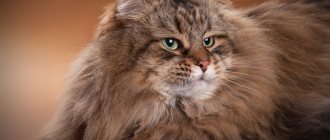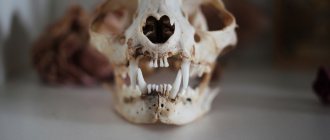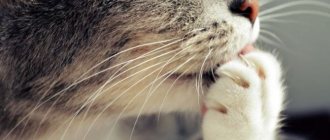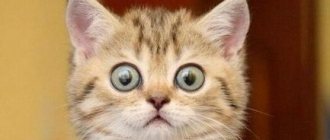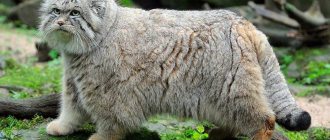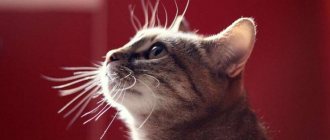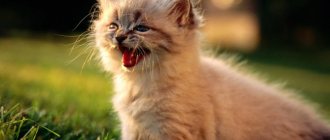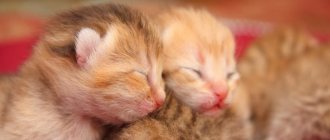Digestive system
The cat's digestive system consists of:
- esophagus;
- stomach;
- small intestine;
- duodenum;
- jejunum;
- liver;
- large intestine.
The esophagus has a hose-like shape of a relatively small size, and connects the animal’s mouth and its stomach. The esophagus originates from the inner base of the mouth, extends through the neck and chest, passes close to the heart, extends through the muscles of the diaphragm, and connects to the stomach. It is important to note that the esophagus is equipped with special muscles that push food into the stomach, producing synchronous movements similar to waves. The esophagus is one of the most difficult organs in terms of surgical treatment, as it is difficult to access and extremely difficult to heal.
The cat's stomach is single-chambered, and is distinguished by the location of the mucous membrane on its inner walls. The cat's stomach is adapted to accommodate a large amount of food, but it is almost never completely filled, since cats are not prone to gluttony (the vast majority). Also, the inner surface of the stomach is dotted with folds, which have an additional mechanical effect on the process of breaking down food. Food processed by gastric juice enters the duodenum through the pyloric sphincter. Most often, eaten food remains in the stomach for about 12 hours.
The small intestine is a tubular organ that connects the stomach and large intestine. Often the length of a cat's small intestine is about 1.5-2 meters, and includes the duodenum, jejunum, and ileum.
The duodenum is small in size and serves to mix food with liver and pancreatic enzymes, which is extremely important for digestion.
The jejunum is the longest part of the small intestine, and its internal walls are dotted with thin hairs, which, when in contact with food that comes into contact with them, penetrate into it and suck out all the useful substances. It is here that the final extraction of all useful substances from food occurs, after which it enters the ileum, and then the large intestine, where it turns into feces.
Features of the external structure of cats
On average, the length of an adult cat excluding the tail is 50-60 cm, with the tail - 75-85 cm. Sexual dimorphism is weak - females are only 5-7 cm smaller than males. The height of cats at the withers is 25-28 cm.
The largest cat, according to the Guinness Book of Records, is a Maine Coon from Melbourne named Omar, its length is 121.9 cm.
A pet weighs on average from 2.5 to 6.5 kg, but there are breeds whose representatives are considered real heavyweights. For example, the jungle cat, Siberian cat and Maine Coon can gain weight up to 13 kg.
Head
Cats have an elongated or rounded head. Relative to the entire body, it is small in size. For example, wild relatives like the tiger and lion have a larger muzzle due to a more massive jaw and pronounced fangs.
The surface pattern of a cat's nose is unique, like a human fingerprint.
The cat can rightfully be called a big-eyed animal. And it's not just a matter of keen eyesight. Cats are among the ten animals with the largest eye sizes relative to the size of their muzzle. Thanks to this feature, cats can immediately see a picture with a 200° field of view without moving their head (for comparison, a person’s visual range is only 180°).
Each cat’s ear is controlled by more than 10 muscles, thanks to which cats can change the position of the ears on the head - press them, bend them, turn them towards the sound, etc.
A special feature of the cat is the presence of very sensitive whiskers on its face. These are hard whiskers, which at the base are penetrated by a large number of nerve endings. Under no circumstances should you pull, let alone tear out, these whiskers - this causes pain to the animal.
With the help of whiskers, the cat receives information about everything that surrounds him - about objects, about the weather, approaching enemies and even the temperature of food
Torso
The body of a cat is divided into the back, chest, and abdomen. According to the relationship of the body to the head and paws, cats have three body types:
- Heavy - these cats have a wide body, a large head and rather short but dense legs and tail.
- Lungs - the body is slender and elongated, the head seems miniature in comparison.
- Medium - in this case, there is maximum harmony between the sizes of the body, head and tail. As a rule, outbred animals have an average body type.
Hair coat is of great importance for a cat. There are no wild naked cats (sphynxes are the result of artificial selection, they are not able to survive in nature). Wool protects the animal from cold, direct rays of the sun, and injuries. Miniature muscles located at the roots of the hairs can raise them on end - at such moments, cats seem larger than usual. This is a defense mechanism designed to scare off the enemy.
Cats love to climb higher - their long tail allows them to maintain balance.
Limbs
Some people mistakenly consider only the pads on which the animal steps when walking and running to be a cat's foot. In fact, it is longer and reaches a protuberance that is a vestigial finger (it can be easily felt, since the claw never retracts into it). It turns out that the cat moves “on tiptoe” all the time.
The photo shows that cats have five fingers - 4 on one side of the pad and one, rudimentary, located away from their “comrades”, on the opposite side
Circulatory system
The circulatory system in cats works the same way as in other mammals: the heart pushes blood through arteries that have elastic walls and rhythmically carry out contraction and relaxation movements. It is thanks to such movements that arteries located close to the skin can be felt, and this is called the pulse. The cat's pulse is easiest to detect on the inside of the thigh, and in a healthy animal it should range between 100-150 beats per minute.
The cat's brain absorbs 15-20% of the blood, the muscular system absorbs up to 40% of the total blood, and about 25-30% of the blood goes to the internal organs. During physical activity, muscles can absorb up to 90% of the blood, which is why cats get tired so quickly, but can focus maximum strength for a short period of time.
What is anatomy?
Anatomy is a branch of science devoted to the study of the structure of the bodies of various creatures. Anatomy helps to establish the common features inherent in a particular species of animal. This science studies the external characteristics of species, the location of internal organs relative to each other, and clarifies their significance and functions.
Anatomy includes the following areas of science:
- osteology , which studies bone structures;
- myology , which studies the structure of muscle fibers, the location of muscles and features of work;
- syndesmology , which studies the elements connecting parts of the skeleton;
- angiology , which studies blood vessels, lymphatic and circulatory systems;
- neurology , aimed at studying the functions of nodes and parts of the nervous system;
- splanchnology , systematizing knowledge about the structure of the respiratory, digestive, excretory and reproductive organs;
- endocrinology , explaining the significance of the endocrine glands;
- aesthesiology , which studies the functioning of the senses.
These scientific disciplines make it possible to trace how the formation of the most important systems occurs, as well as to establish their interrelationships. By studying the anatomy of a cat, you can find out what distinguishes it from other mammals. Anatomical knowledge allows us to understand the purpose of certain structures of the body.
Endocrine system
The endocrine system is primarily responsible for hormones and their production in the corresponding organs. Thus, the cat’s brain produces antidiuretic hormone, oxytocin, corticotropic hormone, adrenocorticotropic hormone, cortisol and growth hormone.
The adrenal glands produce a lot of other hormones, the main purpose of which is to regulate metabolism, and are also responsible for behavioral characteristics. The adrenal glands also produce cortisol, a small portion of testosterone, as well as epinephrine and norepinephrine.
Sense organs
Through the senses, the animal receives basic information about the world around it. As you know, cats have very sharp eyesight and hearing. They can see even in the dark and are able to hear sounds that humans cannot hear.
A description of the anatomical structure of the organs of vision and hearing is important not only in order to get to know your pet better, but also to recognize the presence of pathological changes and know how to help your pet.
Eyes
Visible part of the eye:
- upper eyelid;
- lower eyelid;
- third eyelid;
- Iris;
- sclera;
- pupil.
Cats have relatively large eyes. Cats have stereoscopic vision. This means that they can perceive size, shape and judge the distance to a certain object. Also, cats can see the world around them not only in front of them, but also from the side. Their eyes are capable of capturing images within a range of 205 degrees around them.
Cats' eyes glow in the dark due to the ability of this organ to accumulate rays that enter the eyes during daylight hours. They cannot see in complete and utter darkness. But even a minimal amount of light entering the room allows them to clearly distinguish objects due to the reflection of light from the surface of objects.
© shutterstock
One of the features of cats' eyes is the presence of a third eyelid. This membrane serves as protection against foreign objects entering the cornea. Usually the third eyelid is not visible. It can be noticed in those moments when the animal has just woken up. If it is visually noticeable all the time, or even covers part of the eye, this is a signal about the presence of some pathology in the body.
Ears
A cat's ears are made up of these parts::
- ear canal;
- eardrum;
- middle ear bone;
- vestibular apparatus;
- snail;
- auditory nerve.
Cats have the ability to perceive sounds over a wide range. The physiology of a cat and the structure of its ear allows it to hear high-frequency sounds that are inaccessible to human hearing. A cat can hear about 100 different sounds, while for a person this number is limited to fifty.
There are about 30 muscles around and on the ears that are responsible for movement in this area. Attentive owners notice the cat's ability to move its ears in different directions.
Cat owners should pay extra attention to the structural features of the ear. Your pet should have its ears checked and cleaned regularly. Due to the rather complex structure of the ear, one can often miss the presence of various inflammatory processes and the presence of ear mites.
Nervous system
The nervous system of cats is divided into central and peripheral. Each of these systems in a cat performs functions that are standard for most mammals.
The central nervous system consists of the brain, brain stem and the so-called spinal cord. The central nervous system is the most important in the body of any living creature, and simple and complex reactions, as well as some reflexes, depend on it. In addition, the central nervous system interacts with the peripheral and autonomic ones, ensuring their functioning and control.
The peripheral nervous system is responsible for the cat's conscious motor abilities. So, thanks to this system, a cat can move its paws, extend its claws, run, and generally lead the lifestyle that it leads. Also, the peripheral nervous system transmits pain impulses to the central nervous system from any part of the body where peripheral nerve endings are present.
Description of the structure of the internal organs of a cat and the general anatomy of a domestic animal
Both wild and domestic cats are carnivores. Nature has endowed them with dexterity, acute hearing and smell, and the ability to move silently while tracking down prey. All representatives of the cat family are born hunters. This is evidenced by the structure of their body. Cats share some similarities with other mammals, but they also have unique traits.
What are the physiological features of domestic cats? Do they see colors? How many fingers does a cat have? What allows them to climb trees? How many teeth do kittens have? Which side is a cat's heart located on?
Musculoskeletal system
The cat's body has two main types of muscles: smooth muscle and striated muscle. Smooth muscles are found in all the internal organs of the cat, and are directly connected to the autonomic nervous system, thereby ensuring the work and unconscious functioning of the internal organs, an excellent example of which would be the esophagus and the heart.
The striated muscles are attached to the skeleton and provide the cat with physical strength, the ability to move, hunt and fight. The striated muscles are familiar muscles that we can feel on the limbs and body of the pet.
An important part of the musculoskeletal system of a cat are tendons, ligaments and joints, which in all cats are distinguished by strength, flexibility and enviable elasticity until old age.
The cat's shoulder girdle, which has a unique structure, deserves special mention. Thus, in almost all mammals, the bones of the forelegs are connected to the body with the help of the collarbone, but in cats, the bones of the limbs are connected to the body exclusively with the help of muscles, which provides them with incredible mobility.
Skeleton and its parts
What a cat's body consists of can be found out through anatomy - a branch of biology that studies the structure of the body. First, you should get acquainted with the frame that holds all the important organs, that is, with the skeleton.
There are about 40 more bones in the cat skeleton than in the human skeleton, amounting to 244-250 pieces. The exact number depends on the length of the tail.
Skull and teeth
The cat's skull has 24 bones. 13 of them are on the facial part, and 11 are on the cranial part. Compared to other mammals, a cat's head is quite small in relation to its body, but it has a well-developed brain inside its skull.
The strong jaws of mustachioed pets have 30 sharp teeth. A smaller number (26) is typical only for kittens. By 7-8 months, their milk teeth are replaced by molars, and the dentition is replenished with missing molars.
Spine and tail
A cat's flexibility is due to the amazing mobility of its vertebrae. They can all be divided into 5 departments:
- cervical, consisting of the most massive bones;
- thoracic, to which 8 pairs of ribs are attached;
- lumbar, surrounded by muscles that hold the contents of the abdominal cavity;
- sacral, consisting of 3 fused vertebrae;
- caudal, including from 12 to 28 vertebrae.
Thanks to the massiveness of the cervical vertebrae, the animal can easily turn its head almost 180°, and thanks to its underdeveloped collarbones, it can easily penetrate the narrowest crevices.
The tail plays a special role. With its help, the cat maintains balance while jumping or falling from a height.
Four paws, and there are scratches on them
A cat's paw bones are not directly attached to the skeleton. They are held in place by muscles and tendons.
The hind limbs differ from the front limbs in being longer and having fewer fingers. There are as many of them in front as there are in humans, and in the back there are only 4.
Each of the fingers is equipped with a sharp claw. In a calm state, the claws are retracted into a special pouch, but when you press on the pad, they can be returned back. This is very convenient when trimming overgrown claws.
Due to the unusual location of the knee (right under the belly), cats always walk on tiptoe. This bizarre method of transportation is not only silent, but also very safe. When jumping, the paws absorb all the energy expended, so landing from a great height is soft and quiet.
Stomach
A cat's stomach holds 300-400 ml and takes up about 70%
the entire capacity of the digestive tract, since the main chemical processing of protein foods occurs here. Gastric juice is a clear liquid with a free acidity of 40-60 TU (the same as in humans) and a hydrochloric acid content of 0.1-0.2%, pH = 1.0-2.1 (pronounced acidic environment). Hydrochloric acid neutralizes pathogenic microflora, helminth eggs and activates pepsinogens into pepsins and renin. Pepsins (A, B, C) are the first proteolytic enzymes involved in the hydrolysis of proteins to the stage of polypeptides (albumoses, peptones). Renin actively works in kittens and is necessary for the curdling of mother's milk. Gastric juice also contains lipase, but it has a weak hydrosizing effect on fats; its effect is mainly manifested on milk lipids. The epithelium of the stomach actively secretes mucins (stomach mucus) to protect the wall from the aggressive effects of hydrochloric acid and enzymes.
Reproduction of cats
Anatomy of the cat's reproductive system
The cat's reproductive system includes the testes (testes), seminal ducts, urogenital canal (urethra), epididymis and penis (penis).
The testes (testicles, testicles) are a kind of “factory” for the production of sperm - male reproductive cells (gametes) capable of fertilizing the female reproductive cell and, accordingly, conceiving offspring. Sperm are produced in the testes continuously, until the end of life or castration, and accumulate in the epididymis. From the epididymis during mating, sperm enter the urethra through the vas deferens and enter the cat’s vagina. The most active sperm reach the female gamete (egg) and fertilize it.
For normal sperm formation, a temperature is required slightly lower than the cat's body temperature, so the cat's testicles are located in the scrotum - a skin pouch just below the anus.
In addition to sperm, the testes produce the male sex hormone testosterone, which determines and influences the cat’s sexual behavior. Night screams, marks all over the apartment, stinking urine of an uncastrated cat - all this is the result of the action of the sex hormone testosterone on the body.
Anatomy of the cat's reproductive system
The reproductive system of cats consists of the external genitalia, uterus and ovaries. Conventionally, the mammary glands can also be classified as part of the reproductive system of cats.
The external genitalia of cats, the vulva (labia) and vagina (vagina), are used for copulation and for excretion of urine.
The ovaries produce female reproductive cells (gametes), and, unlike dogs and humans, gametes are released from the ovary only at the time of mating, are captured by the ovarian fringe and descend into the oviducts, where fertilization by sperm occurs. After successful fertilization, the fetuses develop in the uterus.
The cat's uterus is a muscular organ consisting of the cervix, body and horns of the uterus. The cervix is always closed before mating to prevent infection from entering. The cervix opens only during estrus, to allow sperm to penetrate the oviducts.
Cats are prolific animals, capable of bearing from 2 to 8 kittens. The fetuses develop in the horns of the uterus, which can stretch many times.
The signal to the cat that the cat is ready to mate is the release of estrogens (female sex hormones) in the urine.
The mammary glands of cats play a direct role in the process of feeding offspring, producing milk. Normally, a cat has 4 pairs of nipples, located symmetrically along the body from the chest to the groin.
Mating of cats (copulation, mating, mating)
The cat reaches sexual maturity by 5-6 months and is immediately ready to mate with a cat. The mating process is possible only when the cat is in estrus (heat) and her body is ready for ovulation (the formation of female reproductive gametes - eggs). A cat's urine acquires a pungent odor due to saturation with pheromones that attract a cat in heat. When mating, the cat firmly grabs the cat by the scruff of the neck with its teeth, crushes it under itself and performs copulation (sexual intercourse). Skin growths on the head of the cat's penis (spikes) radiate away from the penis and cause a rather painful sensation in the cat's vagina, thereby stimulating ovulation (the maturation of female reproductive cells). Sperm, diluted with the secretion of the cat's prostate, enter the vagina and, thanks to active flagella (tails), move through the cervical mucus into the body of the uterus, and then into the uterus to the oviducts, where fertilization of the egg occurs to form a zygote. A zygote is a complete, fertilized egg capable of dividing. From the zygote, a fetus is gradually formed in the horn of the uterus.
Pregnancy in cats
Pregnancy in a cat occurs after fertilization and lasts an average of 9 weeks. During this time, fruits are formed from fertilized eggs. The pregnancy process ends with childbirth.
Before 3 weeks, pregnancy cannot be determined visually. Starting from the 4th week, the fruits are already available for palpation. Ultrasound diagnostics is effective starting from the 31st day of pregnancy.
From the 5th week of pregnancy, the cat's belly begins to enlarge. Starting from the 6th week, active growth of the fetus occurs, the belly becomes larger. After the seventh week of pregnancy, the cat becomes restless and begins to prepare for childbirth. By palpation you can already determine the shape of the fruit. The nipples begin to enlarge and the mammary glands begin to swell.
3-4 days before giving birth, the cat’s behavior changes greatly; she can follow her owner all day long, meow and prepare a place for herself to give birth. Body temperature during this period drops to 37 degrees.
Respiratory system
The anatomy of a cat is not much different from other mammals. This also applies to the respiratory system. It includes the following organs :
- bronchi;
- larynx;
- lungs.
- nose;
- nasopharynx;
- trachea;
© shutterstock
The breathing process begins from the nose and nasopharynx. The nose has 2 nasal cavities inside, in which, when inhaled, the process of recognizing odors, heating the air and purifying it from impurities, dust, and debris occurs. The cavities are separated by a septum of hyaline cartilage.
The larynx is located between the trachea and pharynx, and is located above the hyoid bone. Basic functions of the larynx :
- air conduction;
- preventing food from entering the respiratory system;
- formation of sounds.
The larynx consists of five movable cartilages and a mucous membrane. It also contains the vocal cords, vocal muscle and glottis. This is where all the sounds that a cat makes are produced.
The purring of cats occurs due to the special location and functioning of the organs of the larynx. Purring occurs without effort on the part of the animal, and has the same rhythm as breathing. In this case, the muscles contract at a frequency of more than 1000 times per minute.
The vocal cords of cats differ in their structure from the vocal cords of other animals. Attentive owners may notice that the pet’s “speech” is not limited to meowing. And even ordinary meowing can be different. It is quite simple to study the “language” of your cat, and you can accurately guess what exactly the pet is telling us. For example, dogs can only make about 10 different sounds. And representatives of some cat breeds can express themselves using about 100 sounds that exist in their “lexicon”.
A healthy animal in a calm state takes about 20-25 breaths per minute. Kittens take breaths and come out more often.
Basic rules of mating
If cats are to be mated, how to carry out the procedure correctly? The question is far from simple for a novice breeder. First of all, you need to decide on a place. It is recommended to carry out the mating procedure in the territory of the male. In this case, the cat will be more active in taking the initiative, and the cat will behave less aggressively in the new place.
The female is transported in a special carrier on the 3rd - 5th day from the start of estrus. The pet owner needs to take with him a tray, a bowl for food and water, and a supply of food. Mating itself occurs quickly, but habituation and courtship can be lengthy. The cat is left with the groom for 3-4 days. Only in this case is there a guarantee that mating will take place without problems and will end with the fertilization of the female.
The carrier with the cat should be placed in a separate room where mating is planned. The pet needs to be given time to get used to the new place and get used to the smell of the male. After the animal gets used to it, the cat is allowed into the room.
Watch this video about the rules of mating cats:
Cat muscle structure
Step 1
Muscles give the body its shape. You can draw the body without knowing the muscle structure, but guessing is not the best way. You might think that this is too difficult, but I will show you that it is not that difficult.
First cover the skeleton with simplified muscle mass. Yes, it's that simple! If you're drawing a very fluffy cat, this is all you need. The muscles will not be visible in any case.
Step 3
Those of us who prefer short-haired or medium-length cats need to learn a little more. They can still be simplified. These are large muscle masses visible under the skin. If you want to learn them painlessly, use this sample to get started. After a few exercises, this structure will be remembered.
Step 5
There is something else. Cats have fairly loose skin; in some places it does not hide the muscles. If you have a cat, try touching the area between the thigh and the back of the shin - you will only feel the skin and fur! This extra skin prevents you from seeing the thigh or back of the lower leg when the cat is sitting.
